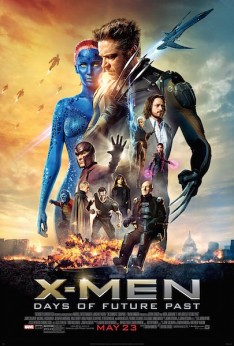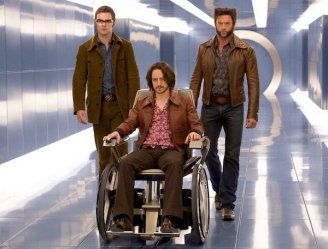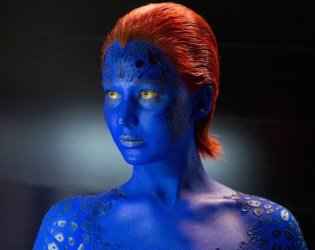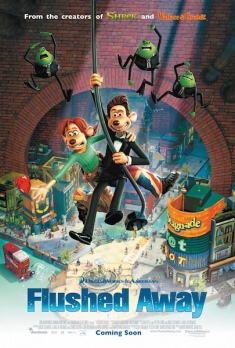
Fear the rest.
Country: USA
Language: English
Runtime: 104 minutes
BBFC: 12
MPAA: PG-13

Original Release: 13th July 2000 (Australia)
US Release: 14th July 2000
UK Release: 18th August 2000
First Seen: cinema, 2000

Stars
Hugh Jackman (Oklahoma!, Les Misérables)
Patrick Stewart (Star Trek: First Contact, Green Room)
Ian McKellen (Richard III, The Lord of the Rings)
Anna Paquin (The Piano, Margaret)
Famke Janssen (GoldenEye, Taken 2)
James Marsden (Gossip, The Box)
Halle Berry (B*A*P*S*, Catwoman)
Director
Bryan Singer (The Usual Suspects, Superman Returns)
Screenwriter
David Hayter (The Scorpion King, Watchmen)
Story by
Tom DeSanto (producer of Apt Pupil & Transformers)
Bryan Singer (Public Access, Superman Returns)
Based on
The X-Men, Marvel comic book superheroes created by Stan Lee and Jack Kirby; and in particular Wolverine, a comic book superhero created by Roy Thomas, Len Wein, and John Romita, Sr.

The Story
In a near future where some humans have mutated to have extraordinary powers, and consequently are hated and feared by the general population, a runaway teen comes under the protection of a mysterious stranger. As a radical leader hunts them for his world-changing scheme, they encounter a school for mutants — and the superpowered team who teach there.

Our Heroes
The X-Men, a team of mutants — humans who have evolved superpowers — organised by Professor Charles Xavier, a wheelchair-bound telepath. There’s team leader Scott Summers, aka Cyclops, who shoots force beams from his eyes; Dr. Jean Grey, potentially an even more powerful telepath than Professor X, who can also move things with her mind; Ororo Monroe, aka Storm, who can control the weather. We’re led into their world by teen runaway Marie, aka Rogue, who can absorb people’s energy, and her reluctant protector, Logan, aka Wolverine, who has metal claws in his hands, can heal really fast, and can’t remember most of his past.
Our Villain
Erik Lehnsherr, aka Magneto, who can manipulate metal. A one-time friend of Xavier’s, they parted ways over his beliefs that mutants and humans couldn’t coexist, which leads him to violently oppose mutant oppression.
Best Supporting Character
Mystique, one of Magneto’s gang, who runs around naked — but that’s because her skin’s blue and bumpy and stuff, so it’s OK. She can shape shift into the form of anyone she’s made contact with, which is very useful for her and very tricky for our heroes.

Memorable Quote
Magneto: “Does it ever wake you in the middle of the night, the feeling that one day they will pass that foolish law, or one just like it, and come for you and your children?”
Xavier: “It does indeed.”
Magneto: “What do you do, when you wake up to that?”
Xavier: “I feel a great swell of pity for the poor soul who comes to that school looking for trouble.”
Memorable Scene
As Magneto, Sabretooth and Toad exit a train station with a kidnapped Rogue, they’re greeted by a sea of policemen. With his powers, Magneto takes all their guns and turns them on their owners. Then Sabretooth grabs Magneto’s throat — he’s being mind-controlled by Xavier. Magneto fires all the weaponry in his control, but stops the bullets just short of their targets — unless Xavier lets him go…
Truly Special Effect
Superheroes really needed the modern era of CGI to make them possible — and, as with everything else, X-Men led the way. Probably the most memorable are Mystique’s skin-changing transformations, which involved 8,000 scales animated in different directions.

Making of
Stanley Kubrick is responsible for the casting of Wolverine. No, really. Well, sort of. Here’s how it goes: Kubrick’s famous perfectionism meant the filming of Eyes Wide Shut overran; that meant star Tom Cruise had to delay his next project, Mission: Impossible II; that sequel finishing later than scheduled meant Dougray Scott — who played the lead villain in M:I-2 and was originally cast as Wolverine — had to drop out of X-Men, which was already on an insanely tight schedule to make its release date. Hugh Jackman was cast on the recommendation of his friend Russell Crowe, who had been sought for the role, and only joined the production several weeks into filming. Apparently if you look closely you can see Jackman’s physique change in various scenes because he was working out extensively while filming continued.

Previously on…
Although this is the first X-movie, I’m sure the enduring popularity of the 1992-1997 animated series can’t’ve hurt the film’s success.
Next time…
In an immediate sense, X2. After that, multiple direct sequels, prequels, and spin-offs. Plus the entire current multitude of comic book movies owe their existence to this film being (a) good, and (b) a hit. Whether that’s a mark for or against X-Men is up to you.

Awards
6 Saturn Awards (Science Fiction Film, Actor (Hugh Jackman), Supporting Actress (Rebecca Romijn), Director, Writing, Costumes)
4 Saturn nominations (Supporting Actor (Patrick Stewart), Younger Actor (Anna Paquin), Make-Up, Special Effects)
Nominated for the Hugo for Best Dramatic Presentation
1 World Stunt Award nomination (Best Speciality Stunt for “Wolverine blown out of truck”)

What the Critics Said
“After trying for decades, Marvel Comics finally may gain the kind of pop-cultural cachet that only comes from a major leap into movies. That movie is X-Men, a fully realized translation of comics’ adolescent power fantasies to adult-level, big-screen entertainment. It’s a film X-Men fans can embrace and action fans in general can appreciate. It has emotion and a solid story to go with its mayhem, and the comics’ central themes aren’t betrayed. Director Bryan Singer gets bang for his buck. At $75 million, X-Men was a modest and rushed shoot for an action showcase, yet its computer generated imaging effects are handsome, and it gleams with polished production design.” — Bruce Westbrook, Houston Chronicle
What the Public Say
“this is a superhero movie with ideas, fully aware of the potential social commentary inherent in its source material. It paints simplistically, in broad strokes, but elegantly. It feels small-scale but full-bodied, and it takes storytelling risks. I mean, the damn thing opens on a concentration camp. The main characters being mutants, discriminated against by ‘normal’ people, gives the screenplay the opportunity to use this as a catchall allegory. Any feared or shunned group of people can find familiar themes at work in the world of the film. […] reflecting on the first X-Men solidifies its status as not just a prelude of better things to come, but as quite a strong movie in its own right. After seeing the franchise move the Golden Gate Bridge, travel decades in time, and resurrect an Egyptian god, it’s refreshing to rewind to this one humble tale of ‘the not too distant future’. The 2000 film has a great lo-fi charm to it, while at the same time being lent gravitas by McKellen and Stewart’s war of wills. It holds up not just as a curiosity, but also as a well-told story of mutants and morals.” — Paul Stanis, A Voyage through Film

I’ve written before (several times) of my near-lifelong fandom of the X-Men. This isn’t where it started (that’d be the classic ’90s animated series), but it certainly helped cement it. Its significance to the current movie landscape is hard to underestimate: it took the superhero subgenre, which hadn’t actually produced that many major movies and had nonetheless reached a comedic nadir with Batman & Robin, and made it respectable blockbuster fodder, which leads directly to where we are today. And the reason it sparked all that is because it’s a quality entertainment in its own right, mixing superpowered action with weighty themes and top-drawer performances from a cast who are almost all better than this, elevating the material rather than besmirching themselves with it. I mean, even without the witty lines and tightly choreographed fisticuffs, anything that has Patrick Stewart and Ian McKellen verbally sparring over a game of chess is bound to bring satisfaction.


#99 will be… X-Men united.

 Once-great detective Sherlock Holmes (Ian McKellen) has retired to the countryside with his housekeeper (Laura Linney), her son Roger (Milo Parker), and his bees, but an unsolved case from late in his career troubles his dementia-addled mind. As he tries to remember the events, we also learn the significance of a trip he recently made to Japan, and the benefits of his growing friendship with Roger.
Once-great detective Sherlock Holmes (Ian McKellen) has retired to the countryside with his housekeeper (Laura Linney), her son Roger (Milo Parker), and his bees, but an unsolved case from late in his career troubles his dementia-addled mind. As he tries to remember the events, we also learn the significance of a trip he recently made to Japan, and the benefits of his growing friendship with Roger. Alongside him, the lad, Milo Parker, is very good, managing to holding his own against the knight of the realm. Also excellent is Hattie Morahan, playing the object of the case in Holmes’ flashbacks. She’s probably best known for playing embattled fellow parent Jane in
Alongside him, the lad, Milo Parker, is very good, managing to holding his own against the knight of the realm. Also excellent is Hattie Morahan, playing the object of the case in Holmes’ flashbacks. She’s probably best known for playing embattled fellow parent Jane in 
 One of the big stories in the run-up to this fifth X-Men film’s release last year (my previous review is
One of the big stories in the run-up to this fifth X-Men film’s release last year (my previous review is  (though the theatrical cut only has 40 chapters, so I’m not entirely sure how that pans out). Most must be teeny extensions, however, and I look forward to
(though the theatrical cut only has 40 chapters, so I’m not entirely sure how that pans out). Most must be teeny extensions, however, and I look forward to  The Rogue Cut is worth seeing for anyone who enjoyed the theatrical version — and, in terms of a copy to own, the Blu-ray comes with both cuts and more special features (though it loses all the extras from the first release, including a few more deleted scenes) — but, unless you’re a huge fan of Rogue or Iceman, it’s not essential.
The Rogue Cut is worth seeing for anyone who enjoyed the theatrical version — and, in terms of a copy to own, the Blu-ray comes with both cuts and more special features (though it loses all the extras from the first release, including a few more deleted scenes) — but, unless you’re a huge fan of Rogue or Iceman, it’s not essential.
 At the start of their audio commentary on The Desolation of Smaug, co-screenwriters Peter Jackson and Philippa Boyens note that, when the decision was made to extend the already-shot Hobbit duology to a trilogy, it wasn’t a third movie that need to be created but a second. That is to say, it was the middle instalment that required the most extra material, including a new prologue and climax. The
At the start of their audio commentary on The Desolation of Smaug, co-screenwriters Peter Jackson and Philippa Boyens note that, when the decision was made to extend the already-shot Hobbit duology to a trilogy, it wasn’t a third movie that need to be created but a second. That is to say, it was the middle instalment that required the most extra material, including a new prologue and climax. The  The extended cut amps him up even more, with an extra part in Mirkwood and a moment where he stands up for Thorin in Laketown. In fairness, he doesn’t have as much character development in this film as the first, while Thorin is on a definite arc and Gandalf is off on his own side-plot, but he’s undoubtedly a key character. I really don’t understand that complaint.
The extended cut amps him up even more, with an extra part in Mirkwood and a moment where he stands up for Thorin in Laketown. In fairness, he doesn’t have as much character development in this film as the first, while Thorin is on a definite arc and Gandalf is off on his own side-plot, but he’s undoubtedly a key character. I really don’t understand that complaint. Even if some of the additions are worthless, on balance this is a better version of the film: more Beorn, more of the atmospheric Mirkwood, an additional character whose appearance will hopefully pay off in the extended
Even if some of the additions are worthless, on balance this is a better version of the film: more Beorn, more of the atmospheric Mirkwood, an additional character whose appearance will hopefully pay off in the extended 
 I think I’ve previously discussed my life-long love of the X-Men franchise, so I shan’t go into detail again, but suffice to say Days of Future Past has been one of my most-anticipated movies ever since the title (which is that of a classic and influential story from the comics) was announced. Thank goodness, then, that the final result doesn’t disappoint.
I think I’ve previously discussed my life-long love of the X-Men franchise, so I shan’t go into detail again, but suffice to say Days of Future Past has been one of my most-anticipated movies ever since the title (which is that of a classic and influential story from the comics) was announced. Thank goodness, then, that the final result doesn’t disappoint. Beyond that, there’s the characters: the younger versions are having to deal with the fall-out from
Beyond that, there’s the characters: the younger versions are having to deal with the fall-out from  Not everyone gets to shine in a cast this big, although pretty much everyone gets a moment. The future-set cast have the least to do, people like Halle Berry turning up to do little more than show their face, though Stewart and McKellen get a moment or two worthy of their talents. After he was the focus of the last film, Fassbender is slightly shortchanged here; but after McAvoy gave him essential support in First Class, Fassbender plays the same service here, informing Charles’ journey. Of the new additions, Evan Peters as Quicksilver (that’s the one who’ll also be played by Aaron Taylor-Johnson in
Not everyone gets to shine in a cast this big, although pretty much everyone gets a moment. The future-set cast have the least to do, people like Halle Berry turning up to do little more than show their face, though Stewart and McKellen get a moment or two worthy of their talents. After he was the focus of the last film, Fassbender is slightly shortchanged here; but after McAvoy gave him essential support in First Class, Fassbender plays the same service here, informing Charles’ journey. Of the new additions, Evan Peters as Quicksilver (that’s the one who’ll also be played by Aaron Taylor-Johnson in  Later, there’s the aforementioned ‘slow-mo’ sequence, and the grand climax, which offers more “fly something big around” antics a la First Class’ submarine, only considerably grander. Yet for all the spectacle, the final moments once again come down to character: what is Magneto prepared to do? What is Mystique prepared to do? Will anyone listen to Charles? And so on. Even the much-vaunted Marvel Studios movies tend to base their climaxes in slabs of ‘epic’ CGI crashing into each other; Days of Future Past does that for a bit, then brings the characters back into focus for the real final beats.
Later, there’s the aforementioned ‘slow-mo’ sequence, and the grand climax, which offers more “fly something big around” antics a la First Class’ submarine, only considerably grander. Yet for all the spectacle, the final moments once again come down to character: what is Magneto prepared to do? What is Mystique prepared to do? Will anyone listen to Charles? And so on. Even the much-vaunted Marvel Studios movies tend to base their climaxes in slabs of ‘epic’ CGI crashing into each other; Days of Future Past does that for a bit, then brings the characters back into focus for the real final beats. (Jennifer Lawrence being the third pillar of the past triumvirate, as they’ve already focused on Xavier and Magneto). While Days of Future Past does wrap up the majority of its threads (the open-ended ones are answered by previous films, if you want them to be), there’s plenty there to play with in the next film (and, perhaps, ones beyond that) if they want to… which they do.
(Jennifer Lawrence being the third pillar of the past triumvirate, as they’ve already focused on Xavier and Magneto). While Days of Future Past does wrap up the majority of its threads (the open-ended ones are answered by previous films, if you want them to be), there’s plenty there to play with in the next film (and, perhaps, ones beyond that) if they want to… which they do. Aardman Animations, the Bristol-based company most famous for
Aardman Animations, the Bristol-based company most famous for